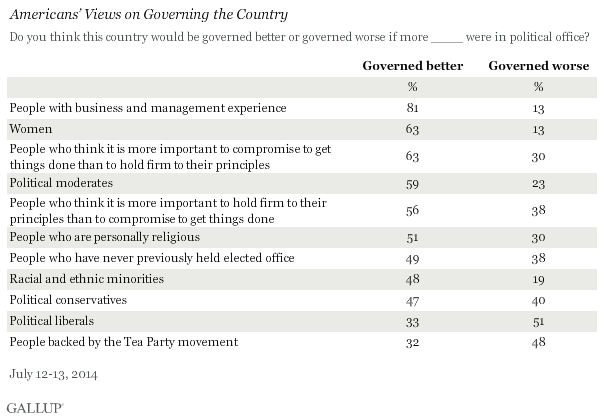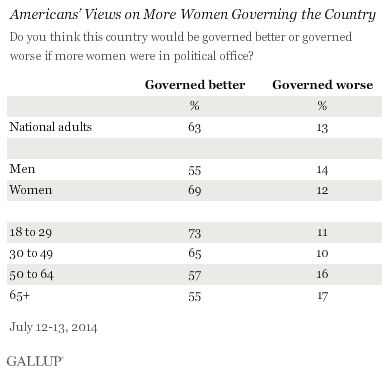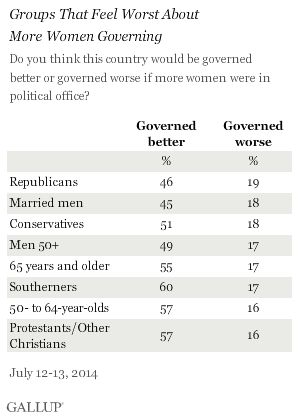WASHINGTON, D.C. -- Four in five Americans (81%) say the U.S. would be better governed if more people with business and management experience were in political office. Meanwhile, 63% say the country would be better governed with more female political leaders -- up slightly from 57% in 1995 and 2000.

These data are from a July 12-13 Gallup poll.
Americans also favor governance by those who "think it is more important to compromise to get things done" (63%) over those who "think it is more important to hold firm to their principles" (56%) -- although the overlap between the figures shows that some Americans view both types of leaders favorably.
Nearly six in 10 Americans say electing more political moderates would improve the way the country is governed, while fewer say this about political conservatives (47%) and political liberals (33%). Thirty-two percent believe the country would be governed better if more people backed by the Tea Party movement were in office, while more, 48%, believe it would be governed worse.
About half of Americans think the country would be better governed if more people who are religious (51%), and more racial and ethnic minorities (48%) were in office.
By a modest 11-point margin, 49% to 38%, Americans believe the U.S. would be governed better, rather than worse, if more people who had never held political office were elected. This suggests that although Americans remain highly frustrated with Congress as an institution and with its members, they don't strongly endorse the idea of having more political novices in office.
Slightly More Back a Greater Female Presence in Politics
The 63% of Americans who believe the U.S. would be better governed if more women were in political office includes 69% of women and 55% of men. Belief that more women would lead to better government decreases with age, but majorities in all age groups agree.

Overall, self-identified liberals (78%), unmarried women (78%), and women aged 18 to 49 (76%) express the most optimism in female leaders. A large majority of blacks (75%), Democrats (75%), and people aged 18 to 29 (73%) also believe having more women in office would improve the government.


Not all Americans share the same enthusiasm for female political leadership, however. While nearly half of Republicans (46%) feel that having more women in office would result in better government, almost one in five (19%) feel such governance would be worse -- the highest percentage among any demographic.
The same is true of married men (45%) and conservatives (51%), who are more than twice as likely to view more female leadership as a positive, while about a fifth (18%) of each group say they feel governance would suffer if more women held political office.
Bottom Line
Although Americans may view certain demographic characteristics or backgrounds as best for leadership in a general sense, that may not be the overriding decision in how they vote. Despite Americans' large agreement, for example, that a business and management background is a desirable political leadership trait, President Barack Obama didn't possess it and still managed to defeat his 2012 opponent, Mitt Romney, who had a long and successful business career before he entered politics.
Though most Americans agree that the country would be better governed if more women were in office, the level of female representation falls far below the proportion of the U.S. population that is female. Currently, there are 20 female U.S. senators, 79 female U.S. House members, and five female state governors in office. This may reflect a lower proportion of women compared with men seeking political office, rather than a rejection of female candidates in general, especially because far more women have been elected to federal or statewide office since 1990 than was true before that.
The conversation about the value of female leadership in U.S. politics is likely to intensify because women are among the Democratic Party's leading potential candidates for 2016, and because various PACs that focus on women continue to call for female candidates in a midterm election year.
Survey Methods
Results for this Gallup poll are based on telephone interviews conducted July 12-13, 2014, on the Gallup Daily tracking survey, with a random sample of 1,023 adults, aged 18 and older, living in all 50 U.S. states and the District of Columbia.
For results based on the total sample of national adults, the margin of sampling error is ±4 percentage points at the 95% confidence level.
Interviews are conducted with respondents on landline telephones and cellular phones, with interviews conducted in Spanish for respondents who are primarily Spanish-speaking. Each sample of national adults includes a minimum quota of 50% cellphone respondents and 50% landline respondents, with additional minimum quotas by time zone within region. Landline and cellular telephone numbers are selected using random-digit-dial methods. Landline respondents are chosen at random within each household on the basis of which member had the most recent birthday.
Samples are weighted to correct for unequal selection probability, nonresponse, and double coverage of landline and cell users in the two sampling frames. They are also weighted to match the national demographics of gender, age, race, Hispanic ethnicity, education, region, population density, and phone status (cellphone only/landline only/both, and cellphone mostly). Demographic weighting targets are based on the most recent Current Population Survey figures for the aged 18 and older U.S. population. Phone status targets are based on the most recent National Health Interview Survey. Population density targets are based on the most recent U.S. census. All reported margins of sampling error include the computed design effects for weighting.
In addition to sampling error, question wording and practical difficulties in conducting surveys can introduce error or bias into the findings of public opinion polls.
View survey methodology, complete question responses, and trends.
For more details on Gallup's polling methodology, visit www.gallup.com.
